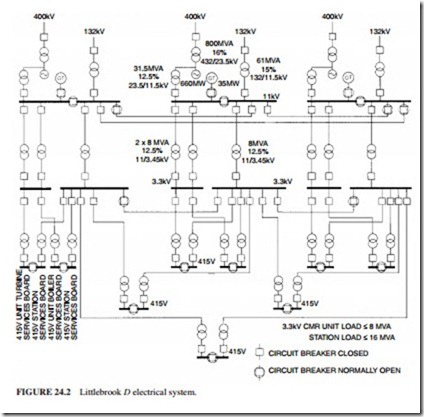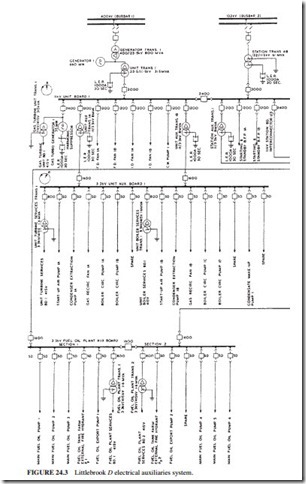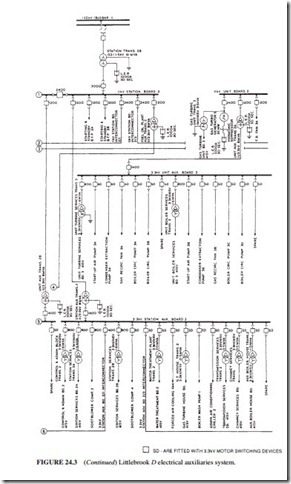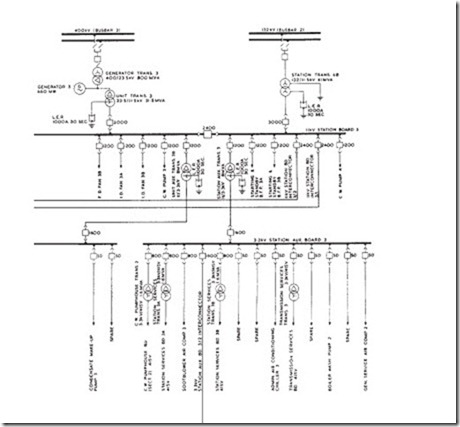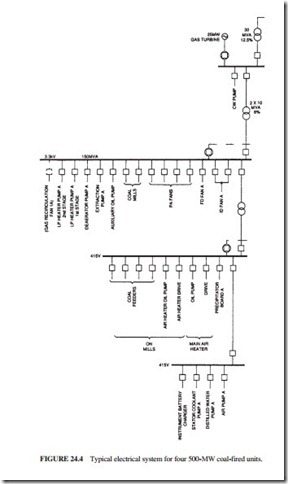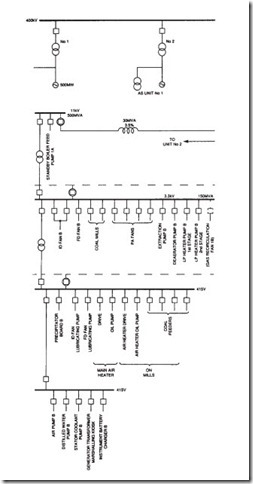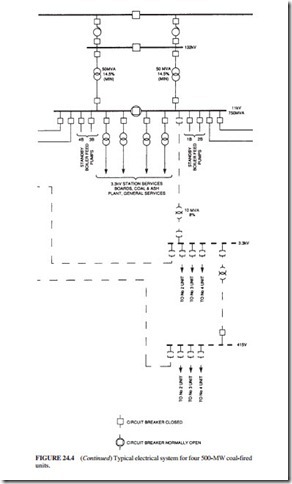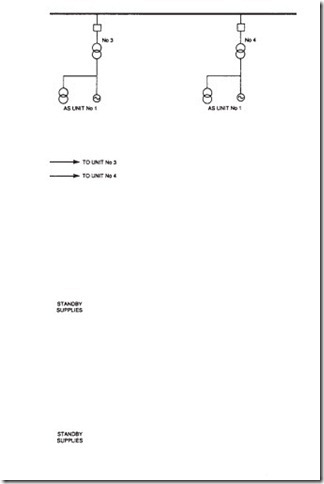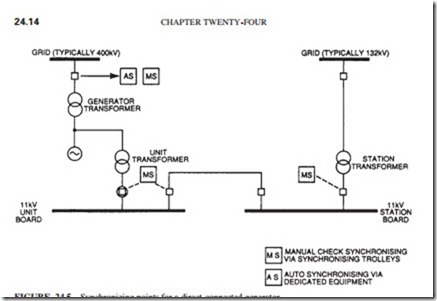SYSTEM PERFORMANCE
Unit Start-up
During start-up, all types of power plants require sufficient electric power from a grid or a larger power source such as a gas turbine. The high-voltage (HV) circuit breaker of the
Shutdown and Power Trip
There are two types of shutdown:
● A controlled shutdown, due to a requested reduction in power generation or prior to an outage.
● An emergency shutdown, due to an internal or external fault. The unit must be disconnected from the grid following this type of shutdown.
Controlled Shutdown. A controlled shutdown consists of the reverse of the start-up sequence. The unit power is reduced to an acceptable level, and the unit auxiliaries are transferred to the station transformer source.
Power Trip. There are five types of power trips in a power plant:
1. Grid faults causing disconnection of a single unit or the whole station.
2. Electrical faults in the generator system including the generator, unit transformers, and the main connections. These faults require the instantaneous opening of the generator HV and unit transformer LV circuit breakers.
3. Mechanical faults in the generator or the turbine including loss of lubrication oil or con- trol fluid, loss of condenser vacuum, etc., requiring unit shutdown. Instantaneous dis- connection of the unit from the grid may not be required following any of these faults. This is so because the turbine-generator overspeed can be prevented when the generator remains connected to the grid for a short time following a fault of this type.
4. Electrical auxiliaries system faults resulting in impairment of equipment leading to a unit trip.
5. Consequential unit trip due to unavailability of steam at the required enthalpy.
The unit is normally subjected to 100 percent load rejection following a fault in group 1. The turbine-generator will overspeed following disengagement of the unit from the grid
POWER STATION ELECTRICAL SYSTEMS AND DESIGN REQUIREMENTS 24.15
due to the excess energy in the steam entering the turbines. The turbine governing system and the automatic voltage regulator of the generator are designed to handle this situation. A backup overspeed protection system is used to trip the steam valves when the governing system fails to limit the overspeed to 10 percent. It consists of bolts driven by centrifugal force against springs. They trip a lever when the overspeed reaches 10 percent, resulting in the shutdown of the steam valves.
The generator remains electrically connected to the grid following a fault in group 3. This is done to limit the overspeed due to steam flowing in the turbines. The unit is dis- connected from the grid when the power measurement relay detects low forward power.
The auxiliary systems are normally subjected to voltage and frequency transients fol- lowing some of the trips listed above. For example, following a load rejection that occurs immediately after a fault in group 1 above, the turbine-generator will overspeed. This will increase the frequency of the power generated and transmitted through the unit transformer to the auxiliary systems. The motors of the auxiliary systems will start to pull higher current due to this increase of frequency. This will lead to the tripping of some of these motors on overload and subsequent impairment of the auxiliary systems.
The faults in groups 1 through 5 will cause a loss of normal electrical supply to the unit. Essential systems within the unit will be supplied from battery-backed systems, local gas turbines, or diesel generators.
The Effects of Loss of Grid Supplies
The loss of grid supplies is a generic term used to cover events that result in a grid voltage and/or frequency outside the operating limits. It can be caused by the loss of power stations or an ice or a wind storm.
From a system operations perspective, it is desirable to keep all the power generating plants connected to the grid during a disturbance that involves a frequency or a voltage transient. This is desirable because the loss of power generating plants reduces the stability of the power transmission system. However, a variation in grid voltage or frequency outside the specified limits can cause impairment of systems inside power plants. For example, a decrease in grid voltage will result in an increase in the current supplied from the grid to the motors inside the power plant. These motors could trip on overload, resulting in impairments of essential systems. These systems will remain impaired until the motors are manually reset.
System impairments will also occur when the grid frequency increases or decreases out- side the specified range. Thus, the designer of the power station should consider deliberate disconnection of the units from the grid when the grid voltage or frequency drifts outside the specified limits. This issue is of great importance to nuclear power plants because the impairment of their safety-related systems could result in meltdown of the fuel and release of radioactive material. However, it is also of importance to conventional power plants because forced outages have significant economic impacts on the station.
